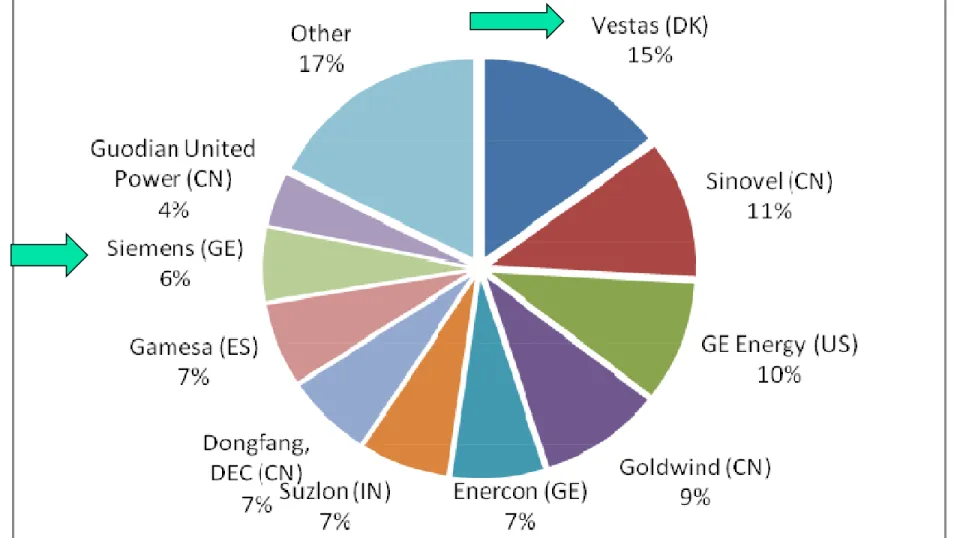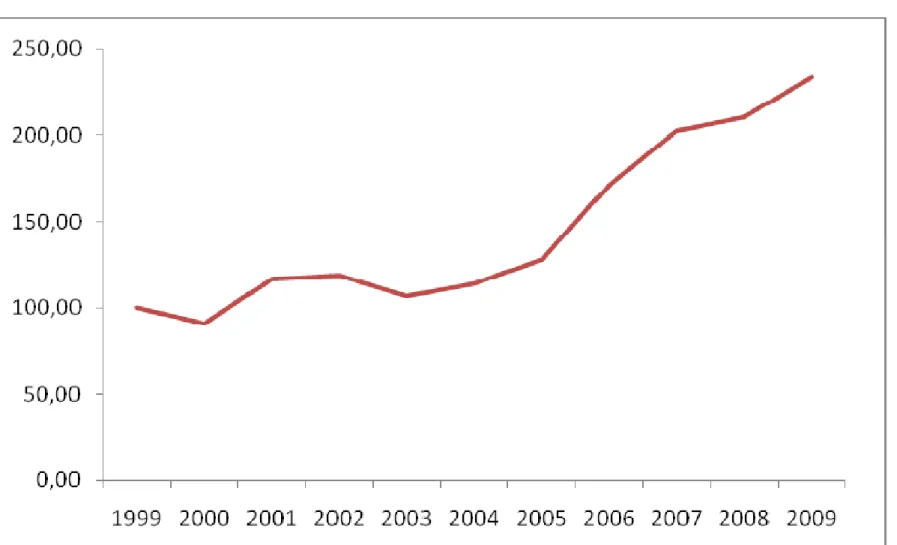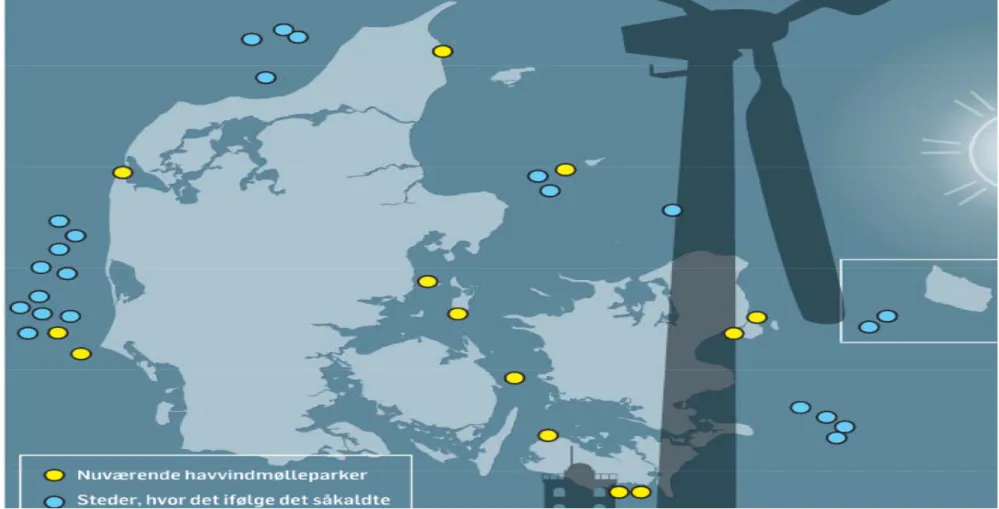Årskonference ’Energi på havet’
Ribe 5. oktober 2011
Regionaløkonomiske aspekter:
Udviklingsperspektiver, klyngedannelse og
g p
p
,
y g
g
ekstern afhængighed
Andreas P. Cornett, IFG,
SDU S
d b
SDU Sønderborg
Energi på havet: Makroanalysen
2 aspekter:
1. Formålet med denne delanalyse er at kortlægge og analysere de
makroøkonomiske determinanter for udviklingen af vindenergi branchen i en international, national og regional kontekst.
Fokus på strukturskift og betydningen af ændringer i de politisk bestemte rammebetingelser
bestemte rammebetingelser
2. Derudover analyseres makroaspekter ved klyngedannelser
2. Derudover analyseres makroaspekter ved klyngedannelser
inden for området, herunder indflydelsen af ændringerne i den globale arbejdsdeling og efterspørgselsstruktur
Her undersøges blandt andet samspillet med den regionale udviklingspolitik og den aktører i et ’Triple Helix’ perspektiv.
Energi på havet: Makroanalysen
Energi på havet: Makroanalysen
•
Globalisering – Erhvervsudvikling – regional balance
l i
f ili
i
i
l
•
Regulering og facilitering: EU – National –
regional/lokal : begrænsning eller facilitator for
k
d
i
l d ikli
sektorens og den regional udvikling
Samspillet mellem analyseelementerne:
Samspillet mellem analyseelementerne:
Branche
Virksomhed
Makro økonomiske Klyngery g
& erhvervspolitiske forhold
Energi på havet oktober 2011 4
Regional vækst og udviklingsmodel
S M difi d fi b d Th Mi i t f th I t i d H lth 2004 28 d Et k it & L d d ff 2000
R
i
l k
i k
l
I dik t
Regionaløkonomisk analyse: Indikatorer
Sektor & branche:
Værditilvækst
Værditilvækst
Export/import
Beskæftigelse
Uddannelse og kompetencer
Uddannelse og kompetencer
Subsidier og støtteordninger
Energi på havet oktober 2011 6
Figure 1 Cluster entities and units entities in an off shore wind energy service and maintenance cluster.
MNC/ Large companies (System providers, anchors in prod. chain, outside the
SME manufacturing and service providers
prod. chain, outside the cluster area, i. Vestas or Siemens Windpower) Consultants Technological Institutes Business Institutes Business Development Agencies etc. Public sector Educational and S B d Et k it & L d d ff 2000 h t d f C tt & I t 2010 58 authorities (local and external) research institutions
According to Porter (2003, p.562), as mentioned din a previous presentation a cluster can be defined:
“...as a geographically proximate group of interconnected companies, suppliers, service providers and associated institutions in a particular field, linked by
li i f i Cl i b f h
externalities of various types. ....Clusters are important because of the externalities that connect the constituent industries, such as common technologies, skills, knowledge and purchased inputs”.
At least in a European context, the Danish Wind power industry fulfills as
whole also the geographical condition. More important to note is that Porter whole also the geographical condition. More important to note is that Porter explicitly stress that an industry can become a part of several clusters, which can cause problems in the empirical assessment of cluster performance (i.e. with regard to employment)
with regard to employment).
From a conceptual point of view the issue is solved by a distinction between
a narrow and broad cluster definition. The former is based on the strongest geographical and location ties of a particular industry. Broad clusters include all industries in the cluster (Porter 2003, p.563)
It is important to note that Porter explicitly stress that an industry can
become a part of several clusters
become a part of several clusters
From a conceptual point of view the issue is solved by a distinction
between a narrow and a broad cluster definition
The development of the wind energy sector has become an important instrument in regional economic development policy in Denmark
( ti b h lik th i iti l th i W t D k)
(sometimes by change like the initial growth in Western Denmark)
The crucial problem is to avoid creating new industrial mono
structures based on a temporary boom
structures based on a temporary boom
The development of off shore wind parks can have a large potential in
this case (including a service cluster)
A crucial condition for a success is to create a sustainable basis which can adapt to alterations in the economic environment
The cluster perspective:
p
p
Spinn-off form a mature & well esteblished
Off h
Cl
Offshore Cluster
Related to a strong national production chain
g
p
Regional dispersed in a DK perspective
Strong cluster in and European perspective
Note: In a way both the mature off shore oil and gas cluster and the
emerging off shore wind cluster has features in common with the ‘satellite platform’ industrial district’ type of production system
k t h d b A M k (1996 304 6)
sketched by Ann Markusen (1996. pp.304-6).
B n hen i egione kl nge elle del f
Branchen i regioner klynge eller del af
klynge?
Fra udstyrs leverandør til system leverandør
Fra udstyrs leverandør til system leverandør
National og international benchmark?
En ny klynge ?
Branchen som del i en regional
Branchen som del i en regional
Mapping clusters in Southern Denmark: Mature clusters
(Klyngeudvikling Syddanmark 2009, p. 24)
Energi på havet oktober 2011 12
Figure 2 Cluster development
g
p
Mature clusters Economic performance Number of clusters Development of clusterGerminating or budding clusters
Potential clusters
Cluster initiative
The global industry vs. regional and national
clustering
g
Home market – installed capacity
Future trends
M k t h
f
i d t bi
Market shares for wind-turbines
Changes in the value chain
g
Lasting regional employment and skill
development
development
Figure 2
Installed Wind Turbine Market
Shares 2010
(Source: Here quoted from Ekopolitan 2011).Figure 3 Global wind power capacity – Regional Breakdown (Source: GWEC 2011)
Figure 4 Turnover per employee in Danish
Windmill Industry (Index 1999 =100)
y (
)
Figure 5
Turnover Danish Wind power industry
Denmark and global (in bill. €)
Source: Vindmølleindustrien 2010Figure 6
Exports of Danish Windmill Industry (%
f t t l D
i h
t )
Figure 7 Actual and Possible Positions of Off shore Windmill
Figure 7 Actual and Possible Positions of Off-shore Windmill Parks, Denmark 2010 Source: Ministry of Environment, here quoted from the newspaper, Politiken (2010).p p , ( )
Figure 9 Geographical distribution of employment in the Danish wind power industry 2009
A N b f l d i i i li B Sh f l i l
A: Number of employed in municipality B: Share of total private employment
Regional Economic impacts
g
p
Production strongholds (declining employment in non
metropolitan regions)
metropolitan regions)
System provision, marketing and R&D increasing
( l ti
d b l t i
t
)
(relative and absolute importance)
Locational impacts:
Power production related activities => potential
p
p
positive impacts in peripheral – coastal areas
Trends toward specialization and functional
Trends toward specialization and functional
diversification
Job and skill change in DK Wind energy
industry
industry
(ERSA2011)Figure 5 Job functions in the Danish Windturbine industry ultmo 2008 and 2009 (pct. of employment)
employment)
T bl 1 S i li ti i Wi d l t d i d t i i W t D k (M 2006 Table 1 Specialization in Wind energy related industries in Western Denmark (Mean 2006-2009)
Plastics Metal Electro Electro eq. Machinery Transport Priv. R&D
Sønderborg 0.75 0.86 5.71 8,75 7.06 0.54 0.11
Aabenraa 0.80 1.53 0.04 0,27, 0.50 1.86 0.15
Tønder 0.73 3.39 0.15 0,27 0.10 0.61 0.08
Esbjerg 0.79 1.67 0.33 2,63 0.94 1.07 0.03
Varde 2.15 1.47 0.75 0.13 1.03 0.61 0.18
South Jutland total 1.33 1.49 0.80 2.31 1.73 1.11 0.26
Herning 0.77 2.75 0.16 1.19 0.60 0.87 0.00
Ikast-Brande 1.25 0.27 0.00 1.24 3.76 0.83 0.00
Ringkøbing 1.21 2.87 0.84 3.30 4.46 0.59 0.81
Western Jutland total 1.18 1.69 1.57 1.07 2.54 0.69 1.15
Randers 1.56 1.66 0.68 0.21 1.23 0.78 0.72
Aarhus 0.40 0.31 0.93 0.64 0.75 1.02 0.97
E t J tl d t t l 1 08 1 00 1 36 0 83 1 02 0 94 0 68
A.P.Cornett Energi på havet oktober 2011 24
Eastern Jutland total 1.08 1.00 1.36 0.83 1.02 0.94 0.68
Perspectives I:
Perspectives I:
Industry:
The perspectives for the Danish wind turbine industry
characterized by fierce competition on markets as well as with
d hi l l i
regard to geographical location.
Furthermore, the organization of the value chain and the nature
f th d t h i t d t t k l ti
of the products are changing toward system or turnkey solutions rather than equipment.
Regional: Regional:
In a spatial setting, the industry has become global with
significant impacts for Denmark and in particular the peripheral significant impacts for Denmark and in particular the peripheral regions where the industry traditional has their strongholds.
Perspectives II:
Clusterering:
The wind power industry is analyzed in geographical context
using a cluster or industrial district perspective. Two aspects or types of clusters has been identified;
a traditional mature cluster which mainly has to be seen. In a
national configuration including production, marketing R& D and all other functions relevant for a industry acting on global and all other functions relevant for a industry acting on global markets. In a European perspective the Danish wind power industry as a wholey
an emerging service and maintenance cluster for off shore wind
parks on the Danish coast. The cluster is a classical spin off from an existing oil and gas service cluster, and partly embedded in an existing organization, Offshore Center Denmark.
Perspectives III:
The Danish windmill cluster and gained strengths and a The Danish windmill cluster and gained strengths and a
considerable first mover advantage as a result of a proactive energy and industry policy. gy y p y
First, there has been a local market for wind power, not only in
Denmark, but also in neighboring countries especially Germany.
Second, a well-skilled and highly productive labor force has
been present especially in the western part of Denmark due to structural changes in other industries.
Third, the Danish environmental and energy policy especially
d i h 1990 i i l d h h f h i d d
during the 1990ties stimulated the growth of the industry, and provided heavy subsidies for small scale wind power producers.
But is this sufficient to cope with new markets and
But is this sufficient to cope with new markets and
Wind Energy Industry in Denmark – from Production
to System Provider
to System Provider
With point of departure in the previous analysis we as a case consider the evolution of Danish wind energy sector
the evolution of Danish wind energy sector Some characteristics of the sector:
Some characteristics of the sector:
The Danish wind energy sector has traditionally been located in the Western part of Denmark
In recent years the industry structure has changed. There are two main companies Danish Vestas and German Siemens
Windpower Windpower
At the moment Danish based producers still maintains a
significant position in the wind turbine segment with a share for g p g
Vestas equal to 15 percent
Energi på havet oktober 2011 28
Paths of Development
The Danish wind energy sector can be characterized as a national cluster according to the cluster classification of g Michael Porter
Originally the industry developed in a decentralized
pattern serving local costumers (this is especially true for Vestas)
The development was supported by generous support
schemes for people investing in wind power (through the electricity system)
electricity system)
Today wind energy related activities are geographical spread throughout the country
spread throughout the country
R&D, marketing and managerial functions has recently to some extent also moved to rural areas in Western
A Regional Service Clusters ?
A Regional Service Clusters ?
The main problem of the off-shore wind turine sector to maintain a
bl i f l t i it
reasonable price of electricity
The final output, electricity is sold on a highly competitive marked under institutional/regulatory and infrastructure constrains
under institutional/regulatory and infrastructure constrains
In particular the latter is of growing significance when the overall share of wind energy is increasing, national as well as in a trans-European perspective
The grid infrastructure and production cost are crucial parameter for the industry
the industry
The shift toward service is hard to identify in official statistics
According to the annual reports from the Danish Windmill industry a According to the annual reports from the Danish Windmill industry a weak trend away from traditional production seems to be visible
Institutional impacts?
Energi på havet oktober 2011 30
Uddybning Triple Helix
Virksomheder: Hovedfokus samspil mellem regionale
virksomheder og branches kernevirksomheder (Vestas Siemens etc.)
Uddannelse & Forskning – Hvilken rolle kan/bør F&U
institutioner varetage for at udvikle sektoren - Uddannelse og efteruddannelse
Off li k l i b idi h liti k
Offentlige sektor: regulering, subsidier og erhvervspolitiske
programmer, Klyngeprogram etc.
Forventede resultater: Forbedrede erhvervsbetingelser for
Forventede resultater: Forbedrede erhvervsbetingelser for
branchen og den virksomheder
Øget gennemsigtighed og kendskab til de relevante Øget gennemsigtighed og kendskab til de relevante
‘Regional impacts of economic transition: From manufacturing to service and knowledge based development: Long term trends and recent Danish experiences in the Wind Energy industry’. (Andreas P. Cornett & Nils Karl Sørensen) Paper for special session 'Regional development, structural changes and services’, 51th Barcelona, Spain 30.8-3.9.2011
Case om vindenergi klyngen: Cornett, A. P. & M. B. Ingstrup (2010): “Cluster Development as an Instrument of Regional Business development Policy: Concepts and Danish Reality”, pp. 43-61 in Brown, Kerry, John Burgess, Marion Festing & Susanne Royer (Eds.) Value Adding Webs and Clusters - Concepts and Cases, Rainer Hampp Verlag München, Mering, Germany, 2010.
‘Regional economic aspects of the Danish Windmill Cluster: The case of the emerging off shore wind energy cluster on the west coast of Jutland’ Paper for the special session 'Cluster development and regional transformation in an economic perspective',14th Uddevalla
Symposium June 16-18, 2011 in Bergamo, Italy. (Andreas P. Cornett & Nils Karl Sørensen) Artikel CESFO årbogen for 2010









